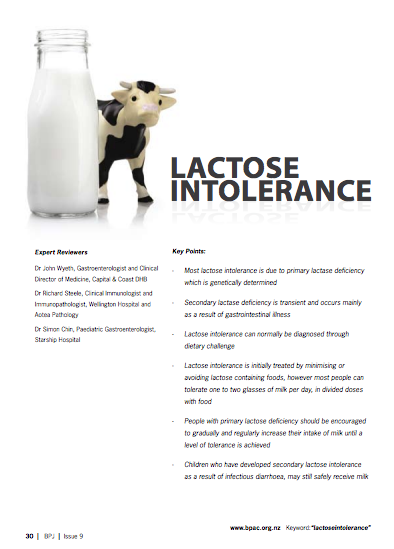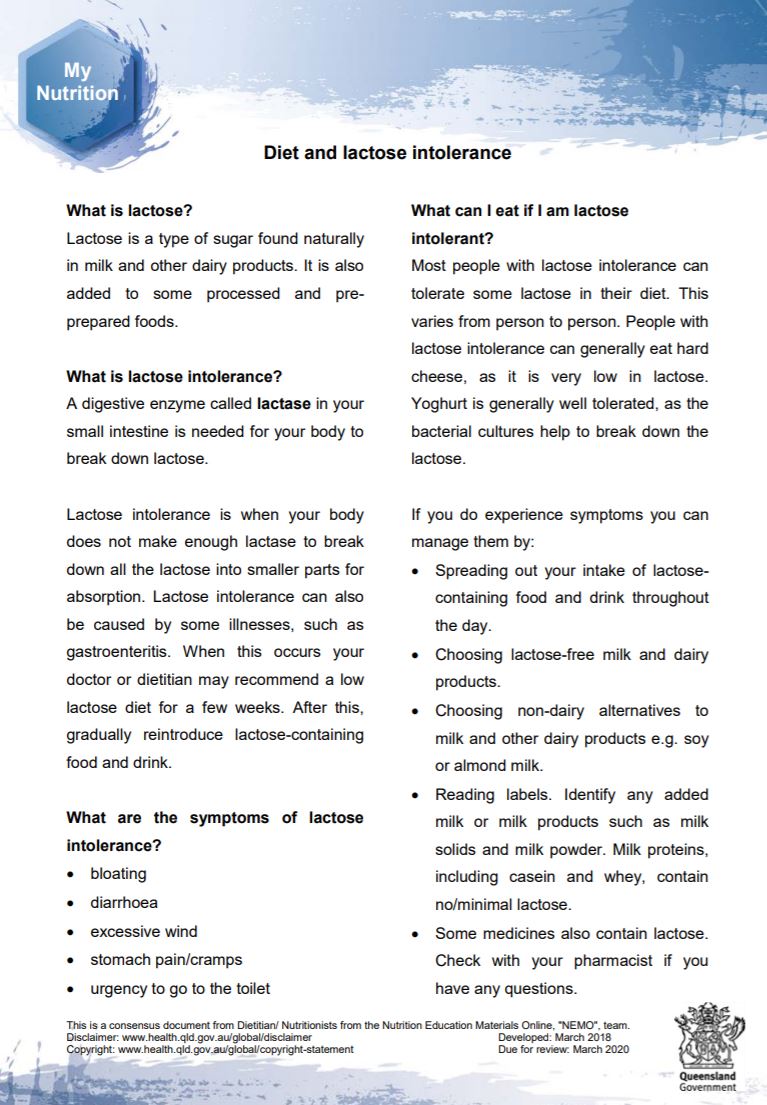Video: What is lactose intolerance?
This video may take a few moments to load.
(Canadian Digestive Health Foundation, 2022)

Low or no data? Visit zero.govt.nz, scroll down the page then click on our logo to return to our site and browse for free.

This video may take a few moments to load.
(Canadian Digestive Health Foundation, 2022)
Lactose intolerance occurs when your body doesn’t produce enough of the enzyme lactase, which breaks down lactose in your gut. Lactase is produced and present in your gut lining. Lack of lactase can be due to a number of causes:
Damage to your gut (small intestine) can occur through surgery or after gastroenteritis (see lactose intolerance after a tummy bug). It can also be caused by conditions such as coeliac disease or Crohn’s disease.
Lactose intolerance after a tummy bug
Lactose intolerance can be temporary, eg, it can come on for a few days or weeks after a tummy bug (gastroenteritis or gastro). This is called secondary lactase deficiency.
Gastroenteritis causes damage to your gut wall, which leads to a decrease in the enzyme lactase. This means lactose accumulates in your gut without enough lactase to digest it. This causes temporary lactose intolerance until your digestive system has had time to repair itself.
The average recovery time for the gut of a baby with severe gastroenteritis is 4 weeks, but may be up to 8 weeks for a baby under 3 months. For older children over the age of 18 months, recovery may be as fast as 1 week.
Most children with gastro can safely continue to receive breast or undiluted animal milk. In babies younger than 3 months, avoiding lactose for a short time may be needed. Your doctor will advise you if an alternative, lactose-free feed, such as soy formula, is needed.
Lactose-free formula milk such as soy milk or casein-based lactose free formula are available to buy from pharmacies and supermarkets.
The use of soy formula should be temporary and is not recommended on an ongoing basis. Read more about infant formula products.
Lactase deficiency is when your body doesn't produce enough of the enzyme, lactase, which helps digest lactose. lactose intolerance is more common in Asian, Middle Eastern, Mediterranean, South American and African people. It may also be more common in Māori and Pasifika people.
What are the types of lactase deficiency?
The most common type of lactase deficiency is primary lactase deficiency, which is when lactase production reduces over time.
This decline often begins at about 6 years of age, but may begin any time. Children who have lactase deficiency may not experience symptoms of lactose intolerance until late adolescence or adulthood.
Babies who are born prematurely may have a condition called developmental lactase deficiency because their gut has not developed adequately. This condition usually lasts for only a short time after they are born and improves as the gut matures.
In very rare cases (less than 50 people have been diagnosed worldwide) people are born with the condition in which their gut does not produce any lactase enzyme. It is noticeable from birth where the baby develops ongoing diarrhoea (runny poos) and does not gain weight or thrive. This condition is called congenital lactase deficiency or alactasia. Babies with this condition need a special diet from soon after birth.
You can also have secondary lactase deficiency, such as after you have had a tummy bug (gastroenteritis).
How does the lack of lactase cause lactose intolerance?
In the absence of lactase, or without high enough levels of this enzyme, your body doesn’t break down all the lactose into smaller monosaccharides for your body to digest and absorb.
The undigested lactose goes into your colon, where it is fermented by bacteria. If there are large amounts of undigested lactose, this causes the symptoms of lactose intolerance.
The symptoms of lactose intolerance are usually non-specific and vary between people. You will usually experience symptoms within 30 minutes to 2 hours after eating. These include:
Symptoms can range from mild to severe depending on the amount of lactose you eat or drink and the amount you can tolerate. As these symptoms are non-specific and can be caused by other conditions, such as irritable bowel syndrome or milk protein intolerance, see your GP for a diagnosis before taking milk products out of your diet.
Lactose intolerance is often confused with milk allergy. These are different conditions.
Read more about cows’ milk allergy or lactose intolerance.
It’s important to see your GP, rather than diagnose yourself. Cutting out milk products without dietary advice may mean you miss out on certain nutrients, such as calcium and vitamin D. Your GP will ask questions about your symptoms and when they occur. It’s a good idea to keep track of what you eat and drink by keeping a diary before seeing your GP.
The condition is usually diagnosed with a trial of taking lactose out of your diet to see if your symptoms disappear. It is then re-introduced at a later stage to find out how much lactose you can tolerate.
There are other tests available to diagnose lactose intolerance, such as a lactose intolerance test or hydrogen breath test. However, these are not sensitive or specific enough to provide an accurate diagnosis, so they are not widely used and rarely needed.
Your GP will let you know if you need further tests.
There is no way to increase your body's production of lactase. However, many people can avoid the discomfort associated with lactose intolerance by changing their diet. Some people find using lactase products helps reduce their symptoms.
Most people with lactose intolerance can cope with some milk and milk products. You may need to experiment to find what’s right for you. The main treatment is to cut down on the amount of lactose in your diet.
You can get lactase tablets or drops from your pharmacy to use on special occasions when you need to eat food that may contain dairy, but this is not recommended for daily use. Check with your healthcare provider before using these products because some groups, such as young children and pregnant and breastfeeding women, may not be able to use them.
For babies with lactose intolerance (usually due to tummy bugs or gastro), lactose-free formula milk is available to buy from pharmacies and supermarkets. However, soy formula isn't recommended for children under 6 months because it contains hormones that may interfere with your baby's future physical and sexual development. Read more about lactose intolerance after a tummy bug above and infant formula products.
Milk and other dairy products contain protein, calcium and some vitamins. These are important for development of strong and healthy bones. If you remove milk products completely from your diet, you may be at risk of conditions such as:
If you are concerned about cutting out milk products and what to replace them with, ask your doctor to refer you to a dietitian.
If you are lactose intolerant there are a few important things to consider when you reduce or remove products milk products from your diet.
Milk and milk products are good sources of calcium. If you remove or restrict your intake of these products you need to replace them with other foods that contain calcium, such as:
Also, make sure you get enough vitamin D. Your body normally makes this in response to sunlight but it is also added to fortified milk because many adults don't get enough from sunlight.
Read more about calcium and vitamin D.
Completely removing lactose from your diet can actually make symptoms of intolerance worse when you next (intentionally or accidentally) consume milk or milk products.
Including a little lactose in your diet encourages the growth of gut bacteria that help to breakdown lactose. This decreases symptoms when you are exposed to lactose.
If you have removed all milk and milk products from your diet and want to re-introduce these, slowly and regularly increase the amount of milk in your diet. This will allow time for gut bacteria to grow, which will help limit symptoms.
It may help to see a dietitian to help you work out how to cut out milk products and what to replace them with. Depending on the cause of your lactose intolerance, you may find it helpful to join one of the following support organisations:
Allergy NZ(external link)
Coeliac NZ(external link)
Crohn’s and Colitis NZ(external link)
The following links provide further information on lactose intolerance. Be aware that websites from other countries may contain information that differs from New Zealand recommendations.
Lactose intolerance(external link) NHS, UK
Lactose intolerance(external link) Patient Info, UK
Lactose intolerance(external link) NIH,US
Lactose intolerance and the breastfed baby(external link) Australian Breastfeeding Association
Lactose intolerance(external link) Best Practice Journal, 2007
Diet and lactose intolerance(external link) Queensland Government, Australia, 2018
Investigating the gut – lactose intolerance(external link) BPAC, NZ, 2010
Lactose intolerance(external link) BPAC, NZ, 2007
Lactose intolerance in infants, children and adolescents(external link) Pediatrics. 2006 Sep;118(3):1279-86

Best Practice Journal, 2007

Queensland Government, Australia, 2018
Credits: Healthify editorial team. Healthify is brought to you by Health Navigator Charitable Trust.
Reviewed by: Dr Helen Kenealy, geriatrician and general physician, Counties Manukau DHB
Last reviewed:
Page last updated: